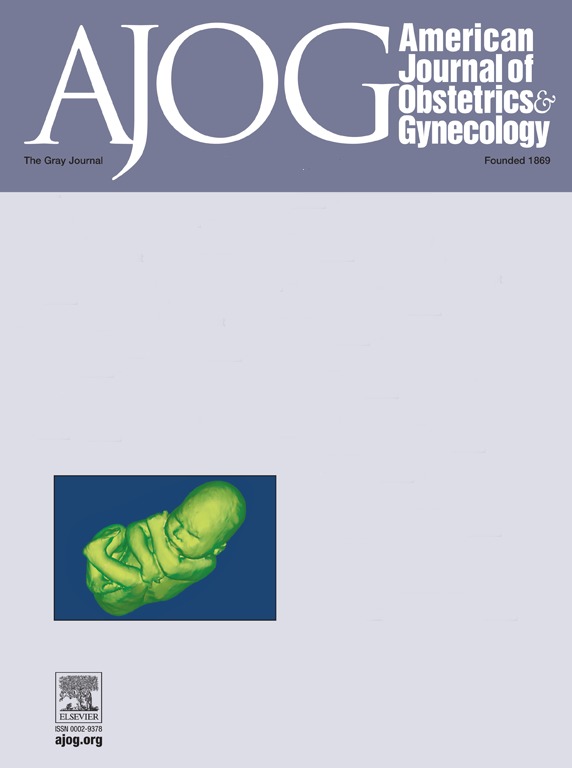Recommended Standardized Terminology Related to the Clitoris and Vestibular Bulbs Based on a Structured Medical Literature Review.
IF 8.7
1区 医学
Q1 OBSTETRICS & GYNECOLOGY
引用次数: 0
Abstract
BACKGROUND There is lack of consensus related to anatomy terminology used to describe the clitoris and vestibular bulbs. OBJECTIVE To report the current state of clitoral and vestibular bulb anatomy terminology in medical literature and compare it to Terminologia Anatomica (TA). The secondary objective is to propose standardized terminology to describe clitoral and vestibular bulb anatomy. STUDY DESIGN PubMed was searched from inception through May 19, 2025 to identify studies reporting on the anatomy of the human clitoris and vestibular bulbs. Studies were included if they had full-text versions available in English and described clitoral anatomy. Articles describing endocrinologically or surgically altered clitoral anatomy were excluded. Select textbooks containing information related to gynecologic anatomy and information collected through prior projects of the SGS Pelvic Anatomy group were also included. Terminology related to the clitoris was extracted, reviewed, and categorized. Through group consensus, categorized terms were deemed accepted, controversial (requiring further description), rejected, or proposed as new terminology. RESULTS Literature search yielded 4738 abstracts and 4 textbooks, which were supplemented with an additional 33 abstracts and 6 textbooks. Ultimately, 184 full text manuscripts and 10 textbooks were included. Six-hundred eighty-seven terms that described 22 well-defined components of the clitoris and vestibular bulbs were identified. Seven terms were categorized as controversial, 6 were rejected, and 2 new terms- clitoral-vestibular septum and clitoral root -are proposed. Regarding the vascular supply to the clitoris, 8 controversial terms were identified and 1 term was rejected. Regarding clitoral innervation, 4 terms were deemed controversial, 5 were rejected, and 1 new term is proposed- spongiosus nerve of the vestibular bulb. Eleven terms described the lymphatic drainage of the clitoris, none were deemed controversial or rejected. Expanding current TA terminology to describe the homologous female structures is recommended for the following terms: Cavernous spaces of corpora cavernosa (A09.4.01.022); Cavernous spaces of corpus spongiosum (A09.4.01.023); Trabeculae of corpora cavernosa (A09.4.01.020); Tunica albuginea of corpora cavernosa (A09.4.01.017); Tunica albuginea (A09.1.01.009). CONCLUSION Currently, terminology used to describe the anatomy of the human clitoris and vestibular bulbs varies. Adoption of standardized terminology can improve communication between anatomists, medical professionals, and learners.基于结构化医学文献综述的与阴蒂和前庭球相关的推荐标准化术语。
背景:关于描述阴蒂和前庭球的解剖学术语缺乏共识。目的报道医学文献中阴蒂和前庭球解剖术语的现状,并与《解剖学术语》(TA)进行比较。第二个目的是提出标准化的术语来描述阴蒂和前庭球解剖。研究设计:检索pubmed从成立到2025年5月19日,以确定关于人类阴蒂和前庭球解剖的研究报告。如果研究有完整的英文版本,并描述了阴蒂解剖结构,就会被纳入研究。文章描述内分泌或手术改变阴蒂解剖被排除在外。此外,本研究还收录了一些包含妇科解剖学相关信息的教科书,以及SGS骨盆解剖组前期项目收集的信息。有关阴蒂的术语被提取,审查和分类。通过小组共识,分类术语被认为是被接受的,有争议的(需要进一步的描述),被拒绝的,或者被提议作为新的术语。结果检索到文献摘要4738篇,教科书4本,补充文献摘要33篇,教科书6本。最终收录了184份全文手稿和10本教科书。687个术语描述了22个定义明确的阴蒂和前庭球。有争议的术语有7个,被拒绝的有6个,并提出了2个新术语——阴蒂-前庭间隔和阴蒂根。关于阴蒂的血管供应,鉴定出8个有争议的术语,1个被拒绝。关于阴蒂神经支配,有4个术语存在争议,5个被拒绝,并提出了1个新术语-前庭球海绵状神经。11个术语描述了阴蒂的淋巴引流,没有一个被认为有争议或被拒绝。推荐扩展当前的TA术语,以描述以下相同的女性结构:海绵体的海绵体空间(A09.4.01.022);海绵体海绵状空隙(A09.4.01.023);海绵体小梁(A09.4.01.020);海绵体白膜(A09.4.01.017);白膜虫(A09.1.01.009)。结论目前,用于描述人类阴蒂和前庭球解剖结构的术语各不相同。采用标准化术语可以改善解剖学家、医学专业人员和学习者之间的交流。
本文章由计算机程序翻译,如有差异,请以英文原文为准。
求助全文
约1分钟内获得全文
求助全文
来源期刊
CiteScore
15.90
自引率
7.10%
发文量
2237
审稿时长
47 days
期刊介绍:
The American Journal of Obstetrics and Gynecology, known as "The Gray Journal," covers the entire spectrum of Obstetrics and Gynecology. It aims to publish original research (clinical and translational), reviews, opinions, video clips, podcasts, and interviews that contribute to understanding health and disease and have the potential to impact the practice of women's healthcare.
Focus Areas:
Diagnosis, Treatment, Prediction, and Prevention: The journal focuses on research related to the diagnosis, treatment, prediction, and prevention of obstetrical and gynecological disorders.
Biology of Reproduction: AJOG publishes work on the biology of reproduction, including studies on reproductive physiology and mechanisms of obstetrical and gynecological diseases.
Content Types:
Original Research: Clinical and translational research articles.
Reviews: Comprehensive reviews providing insights into various aspects of obstetrics and gynecology.
Opinions: Perspectives and opinions on important topics in the field.
Multimedia Content: Video clips, podcasts, and interviews.
Peer Review Process:
All submissions undergo a rigorous peer review process to ensure quality and relevance to the field of obstetrics and gynecology.

 求助内容:
求助内容: 应助结果提醒方式:
应助结果提醒方式:


